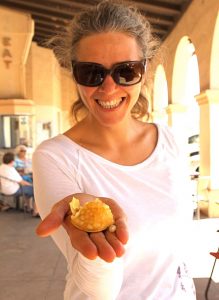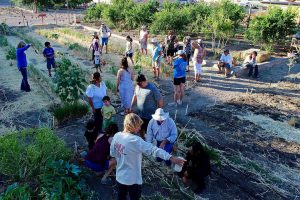Whether you're a seasoned gardener or still just testing the waters (or soils, as it were), you've probably discovered that gardeners & their approach to cultivation are as wonderfully diverse as the plants they tend and indeed, the folks themselves. What freedom and adventure our little patches of earth can offer us! But don't take our word for it, each month we invite local garden folks to respond to 12 questions about their gardening adventures. This month, we’re hearing from Nina, Executive Director of the Ajo Center for Sustainable Agriculture.
Nina has several sunken garden beds and a food forest at her house, as well as sunken and raised garden beds on her next-door neighbor’s property in Ajo, Arizona. As the Executive Director of the Ajo Center for Sustainable Agriculture, opens a new window, she and her partner Sterling Johnson also grow food at the Many Hands Learning Center and Urban Farm at the former Curley School in Ajo, Arizona.
Combining traditional European and Tohono O’odham wisdom with biodynamic and permaculture approaches, the Many Hands Learning Center is dedicated to experimenting with Sonoran Desert and other desert-adapted crops, and demonstrating a variety of techniques to empower community members to grow their own food. The Learning Center is the hub for the Ajo Gardeners Network (over 120 families strong in Ajo and the surrounding area), the site of the Adopt-A-Sonoran-Desert-Crop program (a citizen participatory conservation program), and includes the oldest heirloom pomegranate orchard in Arizona. The Many Hands learning center is named in honor of all the hard volunteer and community work – it takes a community to change the local food system! In addition to weekly Open Farm sessions, workshops, and farm-to-table events, the Learning Center is always open for visitors to come in and enjoy on their own (just please close the gates!!)
1.) When did you first discover your green thumb?
I was born into a family of gardeners, and for the longest time, I didn’t feel like I had inherited a green thumb at all. When I was a kid, one of my chores was to weed the strawberry and carrot patches my mom and my dad carefully cultivated for us each year. I didn’t really want to do it, and my mind wasn’t on the task, so I quickly identified what was supposed to be a “strawberry shoot” and a “carrot”, and which plants were weeds, and started automatically pulling the plants out. Luckily, my mom was keeping a close watch, but by the time she stopped me I had managed to build up quite a pile of “weeds.” I only started gaining confidence as a gardener when I got a garden of my own when I was in law school, and tasted my first harvests.
2.) What is your favorite time of year (season) to garden?
I love southern Arizona gardening, as you can grow all year round. My favorite times are always planting times – fall, spring or summer – the time of new beginnings, hopes and dreams for the future.
3.) Biggest gardening success? Flop?
I love finding and trying out new varieties, and I love watching them succeed in my garden. But overall, I feel extremely successful every time I am able to harvest anything from the garden. I love a huge harvest of winter squash – it just screams abundance!—but I also love capturing a few precious Afghani Sesame seeds from their “exploding” pods to replant next year. As an educator, I love celebrating other people’s successes too: when a person grows and tastes their first carrot, broccoli or tomato, when they realize “yes, I can”.
I do not believe there is such a thing as a gardening “flop” – if it does not work (e.g. seeds don’t germinate, get eaten, dry out, or the plants don’t thrive), observe the situation and try to figure out what is going on. Maybe the soil needs amending, perhaps there is an imbalance in insect populations, or you chose the wrong variety of plants for the time of the year or your conditions. There’s always something to learn about your soil, your weather and your plants, and there’s always another season just around the corner and time to replant.
4.) Do you grow from seed or starts?
I do both, and I grow my own starts, too. Diversifying and distributing the odds seems like the best tactic in our unpredictable environment.
5.) Favorite recipe for your harvest?
I love soups, and anything from the garden can be added to a base of onions sauteed in good olive oil. I love combining pre-cooked legumes such as tepary beans or chickpeas with seasonal veggies (squash, eggplants, chilis, tomatoes in the summer, carrots, turnips, potatoes and leafy greens in the winter), adding garlic, bay leaf, sea salt, herbs and some water or home-made beef stock, and then letting it all cook together in one pot. I like to puree a few ladlefuls and add it back in to achieve richness, or add home-grown grains (barley or White Sonora Wheat), or pasta for a filling meal.
6.) What special challenges do you face gardening in the desert?
A NRCS soil specialist proclaimed Ajo’s soil to be the “worst soil for agriculture in Arizona,” due to the large amounts of caliche and low sand and mineral content, not to mention the mining history. So all of my efforts go into building good soil. At the Learning Center, we had to use radical “urban agriculture” methods: remove 3-4 feet of soil, and build up gardening soil with not much but sand from the wash and horse manure and straw from the neighboring ranchers. I have been collecting household kitchen scraps, coffee grounds from the town cafes, and scraps from the restaurants, but they do not amount to enough compost to create the rich loam that food plants need. And the nearest source of good compost is a two-hour-drive away in Phoenix! So I have been focusing on developing an on-site soil-building methods such as identifying soil-building plants (legumes, grains, cover crops), chicken coop designs, as well as designing desert-adapted “hugelkultur, opens a new window” beds (sunken beds filled with smaller and larger types of organic matter which will slowly decompose over the years to come).
7.) What are you growing now? And what are you getting ready to plant?
Right now, in our Learning Center gardens we are growing a variety of crops from the Adopt-A-Sonoran-Desert-Crop program, including Tohono O’odham yellow-meated watermelon, melon and squash, Tohono O'odham 60-day corn, Magdalena Big Cheese squash, Magdalena sugar cane, and Bisbee Red Cowpeas. Also, the pomegranates are starting to ripen. But I am already dreaming up the fall planting, and my home gardens are already planted with the first of the I’itoi onions, beets, carrots, fennel, and a variety of arugulas, red lettuces and kitchen herbs. [Editor's note: to see if we have any of the seeds Nina mentions currently available in our Seed Library, simply search for the name of the plant, e.g. "Magdalena Big Cheese squash," in our catalog! See the Seed Library page, opens a new window for more details.]
8.) Planting dates, do you follow religiously or do you tempt fate and experiment with when to plant?
There are no official planting calendars issued for Ajo, so over the years I have developed my own, based on my personal experience, the Tohono O’odham seasons, the work of farmer Frank Martin in Phoenix and Tucson’s planting calendars (even though Ajo is 2-4 weeks ahead of Tucson, and is hotter and much drier). Also, each year is different, so I pay close attention to the temperatures of the air and soil, slight changes in the light, and observe the behavior patterns of birds and insects.
9.) Most indispensable garden tool?
Sunglasses, a hat and a water bottle! I work with lots of different folks, and things can get a bit out of hand, so I have been known to improvise just about any tool, but long hours in the sun are much easier with good cover and hydration. And of course, good company!
10.) What’s your favorite gardening book?
I LOVE gardening books, plant books, cookbooks and food system books, so I would say just about anything I am reading at the moment. Right now, that would be John Slattery’s Southwest Foraging, but I can’t stop raving about Lentil Underground – what a great inspiration! The most formative books for my gardening here have most definitely been “From I'itoi's Garden : Tohono O'odham Food Traditions,” published by Tohono O’odham Community Action (or “the Bible,” as we called it when I worked there), and David Owens’ Extreme Gardening.
11.) If you were a plant, what plant would you be and why?
A squash! They can grow anywhere, even from a pile of manure, provide their own shade, protect themselves and other plants with spikes, generously give to others (like the bees), produce fruit that can be eaten whenever we are ready (in a delicate young or hardy mature stages) however we like it (savory or sweet), and provide their own storage container for their meat that can be stored for months. I think that if we only grew enough squash, nobody would ever go hungry. Plus, the geneticists say we share 75% of our DNA with squash, anyhow.
12.) Are you a seed saver?
Yes, and a ferocious one, too! It started with my mother giving me my great-grandmother’s Calendula seeds years ago. I deeply honor the origin of each seed, the generations that lovingly tended the plants and cooked the food for their loved ones, and all the knowledge and wisdom these little “parcels” contain. They are pure power waiting to be activated; they are here to work with anyone willing to work with them, and in the process not just teach us about place and food, but about ourselves, too.
[Editor's note: visit our Seed Library FAQs, opens a new window and the Library's catalog, opens a new window for more info on seed saving!]






